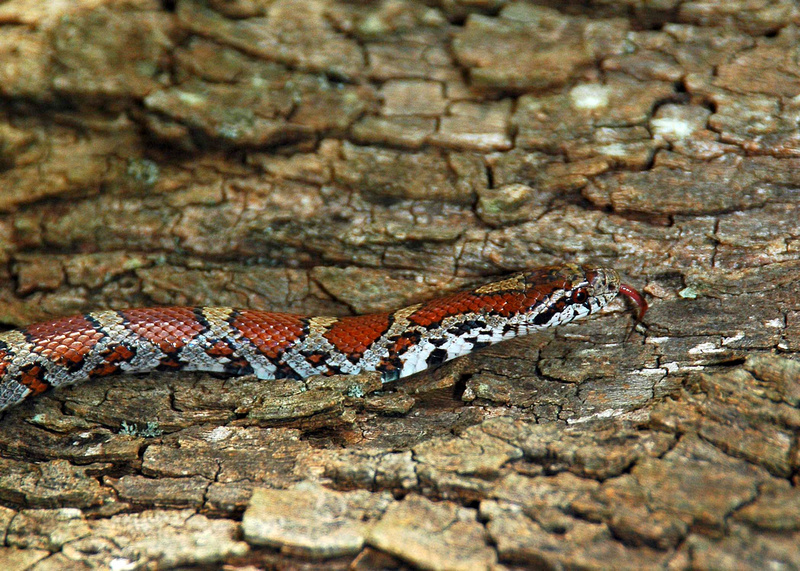Snakes are one of the most misunderstood animals in West Virginia. Did you know these colorful and fascinating reptiles play an important role in healthy ecosystems? If not for snakes, our forests and your yard would probably be overrun with rodents and pests. So, take a few minutes to get to know West Virginia’s snakes. Here are a few facts you need to know.
The 23 species of snakes found in West Virginia range in size from about 10 inches to more than six feet in length. Snakes are complex and highly adapted animals that inhabit a variety of habitats. Color, size, shape, preferred habitat and geographical range are summarized below.
How many snake species are in West Virginia?
West Virginia has 23 species of snakes. Only the Northern copperhead and Timber rattlesnake are venomous.
What’s the difference between venomous and non-venomous snakes?
Identifying venomous and non-venomous snakes is easy if you know where to look. In West Virginia, venomous snakes have vertical pupils and non-venomous snakes have round pupils (there are venomous snakes that have round pupils in the United States – coral snakes – but these aren’t found in West Virginia). Here are a few other things that are unique about West Virginia’s venomous snakes.
- Do not lay eggs
- Give birth to live babies
- Are pit vipers
- Hunts and locates prey by using infrared sensing organs, called “pits”
West Virginia’s northern copperhead is the most common venomous snake in the state. You can identify them by their distinct, bent hourglass shape over their back.
Timber rattlesnakes, which is the official state reptile, are less common and found in mountainous areas with talus slopes. They come in a wide array of color patterns, such as black, yellow and combinations of these colors. At birth, a timber rattlesnake will have one “button” on its tail. As it grows and sheds its skin, a timber rattlesnake’s tail grows a new segment. These snakes are docile and will not bite unless provoked, so keep a safe distance if you spot one.
When are snakes active?
West Virginia’s snakes are most active between April and October when temperatures are suited for these cold-blooded reptiles. Because snakes can’t regulate their body temperatures, their ideal temperature is about 85 degrees. If a snake needs to warm up, it will go to a warmer place, such as a rock in direct sunlight. If it gets too hot, it will slink away to cool off in the shade of a rock, bush or other kind of cover. Like other reptiles, snakes hibernate during the winter months.
What should I do if a snake bites me?
It’s rare for snakes to actively attack humans, but snakes will bite, as wild animals will do, when they are provoked or feel threatened. This can happen when someone tries to kill a snake, so it’s better to leave a snake alone.
Medical treatment is rarely needed for non-venomous snake bites, but if one bites you, here’s what you need to do:
- Wash the wound with soap and water
- Watch for infection
About 40 percent of venomous snakebites are dry bites, which means no venom was injected. However, you should seek medical treatment immediately after a venomous snake bite. If a venomous snake bites, here’s what you need to do:
- Stay calm
- Wrap the wound in a sterile dressing
- Seek immediate medical treatment
- Don’t try to kill the snake
- Don’t try to identify the snake (the same antivenin is used to treat all West Virginia snake bites)
- Do not use a tourniquet, ice or alcohol on the wound
- Do not cut the snake bite and suck out the venom
How do I keep snakes off my property?
If snakes are on your property, they are there looking for food. To keep snakes off your property, remove any material that attracts mice and other rodents and clean up any outside pet food that may attract rodents. Commercial chemical snake repellants do not work.
Snake Facts
- Snakes are vertebrates and can have hundreds of ribs, though they don’t have leg, arm, shoulder or hip bones.
- Snakes have a specialized lower jaw that is split in the front and attached with ligaments. This allows snakes to open their mouths extra wide to eat their prey whole.
- Snakes have teeth pointing to the backs of their throats.
- Venomous snakes have hollow, front, retractable fangs.
- Snakes don’t have external ear openings or hear like humans do. Instead, snakes hear by feeling vibrations in the ground.
- Snakes stick out their tongues to explore their surroundings and taste the air.
- Snakes have a specialized gland, called the Jacobson gland, that tells their brains what they are tasting or smelling.
- Snakes have a forked tongue and can independently move their tongue forks to sense direction.
- Snakes are carnivores and eat other animals, such as insects, invertebrates, fish, amphibians, small rodents and even other snakes.
- Snakes can go months without eating.
- All snakes shed their skin several times a year.
Snake Myths
- Snakes don’t hypnotize their prey.
- Snakes won’t chase you, but they can bite and may stand their ground if threatened.
- Milk snakes don’t drink milk from cows.
- Corn snakes don’t eat corn.
- Snakes don’t bite their tales and roll down hills.
- Snakes are not slimy; they are dry and scaly.
- Snake don’t have to be in a coiled position to strike. Snakes can bite from any position.
- You can’t tell the age of a rattlesnake by counting the number of segments on its rattle.




